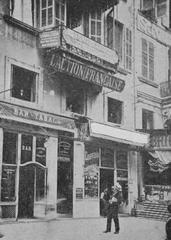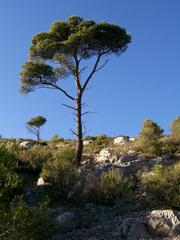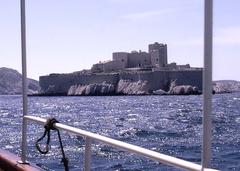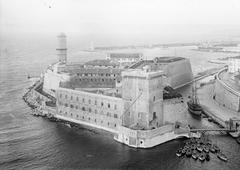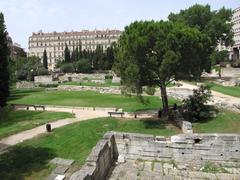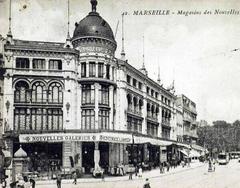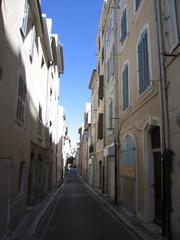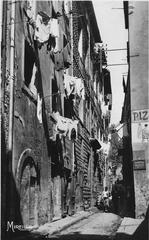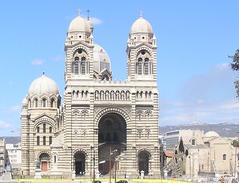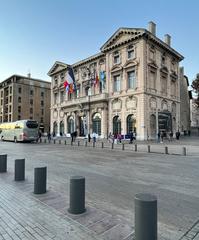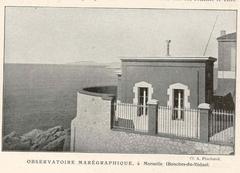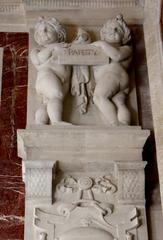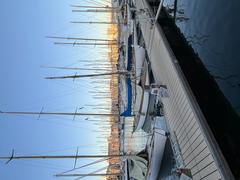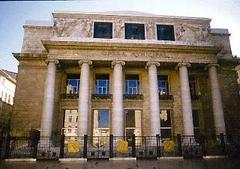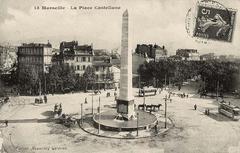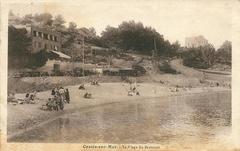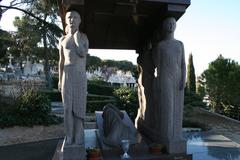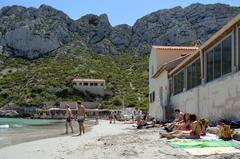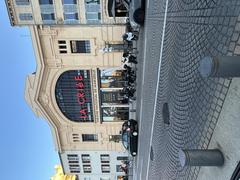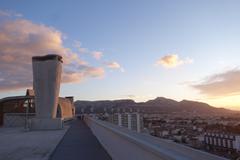Fig Tree Cave Marseille Visiting Hours, Tickets, and Tourist Guide
Date: 15/06/2025
Introduction: Fig Tree Cave Marseille — History and Significance
Fig Tree Cave is a notable name shared by two remarkable sites: one in Marseille, France, and the other in New South Wales, Australia. Each site offers a unique blend of natural wonder and cultural heritage.
In Marseille, the Grotte du Figuier (Fig Tree Cave) stands as a symbol of Mediterranean abundance, resilience, and centuries-old traditions. Nestled just outside the bustling city, it invites visitors to explore its scenic beauty and deep-rooted connections to local folklore, culinary practices, and spiritual symbolism. Events such as fig harvest festivals and guided tours further immerse travelers in Marseille’s rich cultural tapestry (Grow Billion Trees; Silent Balance).
Simultaneously, Fig Tree Cave in New South Wales is a highlight of the Wombeyan Karst Conservation Reserve, drawing visitors into a spectacular world of limestone formations, rare stromatolites, and Indigenous cultural significance. Its self-guided tours, family-friendly facilities, and educational programs make it a premier destination for nature and history enthusiasts alike (NSW National Parks; Visit NSW).
This guide primarily focuses on Fig Tree Cave in Marseille, clarifying distinctions between the two sites and providing comprehensive details on visiting hours, tickets, accessibility, travel tips, and the cultural and ecological importance of the cave. Practical advice, FAQs, and event highlights ensure travelers can plan a rewarding visit to either destination with clarity and confidence (Nomadic Matt).
Contents
- Introduction
- Visiting Fig Tree Cave Marseille
- Opening Hours
- Tickets and Booking Information
- Accessibility
- How to Get There
- Best Times to Visit
- Nearby Attractions
- Special Events and Guided Tours
- Cultural and Symbolic Significance
- Fig Trees in Mediterranean and Marseille Culture
- Symbolism in Ancient and Modern Contexts
- Local Folklore and Identity
- Ethnobotanical and Culinary Importance
- Healing, Wellness, and Ecology
- FAQ: Visiting Fig Tree Cave Marseille
- Practical Tips for Visitors
- Summary Table: Key Symbolic Themes
- Explore More
- Fig Tree Cave at Wombeyan Karst Conservation Reserve (NSW, Australia)
- Introduction and Significance
- Access, Hours, and Tickets
- Cave Environment and Safety
- Tour Experience
- Events and Tips
- FAQ
- Useful Links and Contacts
- References
Fig Tree Cave Marseille: Visiting Hours, Tickets, and Cultural Significance
Opening Hours
- Regular Hours: 9:00 AM – 6:00 PM daily
- Summer (June–September): Extended to 8:00 PM
- Note: Check the official Marseille tourism website for updates, as hours may vary seasonally.
Tickets and Booking Information
- Admission: €8 (adults), €5 (students and seniors), free for children under 12
- Booking: Purchase tickets on-site or online via Marseille’s official ticketing platform.
- Guided Tours: Available with advance booking; tours provide historical and cultural context.
Accessibility
- Facilities: Paved paths and ramps to the main entrance.
- Cave Interior: Some uneven terrain; limited accessibility for those with significant mobility challenges.
- Assistance: Contact management in advance for support.
How to Get There
- Location: Approximately 10 km from Marseille city center.
- By Public Transport: Bus line 21 from Castellane.
- By Car: Parking available near the cave.
- Tip: Public transport schedules can vary; plan ahead.
Best Times to Visit
- Early mornings and late afternoons: Fewer crowds and cooler temperatures.
- Spring and autumn: Enjoy pleasant weather and lush surroundings.
Nearby Attractions
- Calanques National Park: Iconic for hiking and coastal vistas.
- Old Port (Vieux-Port): Historic heart of Marseille.
- Basilique Notre-Dame de la Garde: Panoramic city views.
Special Events and Guided Tours
- Fig Harvest Festivals: Celebrate the fig tree’s significance with tastings, workshops, and cultural events.
- Seasonal Tours: Explore the cave and fig groves with expert guides.
Cultural and Symbolic Significance of Fig Tree Cave
Fig Trees in Mediterranean and Marseille Culture
The fig tree (Ficus carica) is a cornerstone of Mediterranean identity, revered for its fruit and emblematic of abundance, fertility, and resilience. In Marseille, a city shaped by centuries of trade and migration, the fig tree is a natural and cultural touchstone, reflecting influences from Greek, Roman, North African, and Middle Eastern traditions (Grow Billion Trees; Silent Balance).
Symbolism in Ancient and Modern Contexts
- Prosperity & Fertility: Associated with harvest, wealth, and fertility since ancient times, especially in Greek and Roman lore (Florist Empire).
- Protection & Resilience: The fig tree’s hardiness mirrors the perseverance of Marseille’s people; its broad leaves symbolize shelter and safety (Florist Empire).
- Spiritual Growth: In both Christian and Buddhist traditions, the fig tree is a symbol of wisdom and transformation, echoing the cave’s aura of reflection and renewal (Silent Balance).
Local Folklore and Identity
Provençal tales often feature fig trees and caves as places of refuge and sustenance. These stories highlight the landscape’s importance in shaping local identity and collective memory (Tourist Guide Map; Brainwise Mind).
Ethnobotanical and Culinary Importance
Figs are central to Provençal cuisine, enjoyed fresh or dried, and featured in pastries and savory dishes. Fig leaves are used for flavoring, and the wood is crafted into local wares. Sampling fig-based specialties in Marseille’s markets connects visitors to the region’s botanical heritage (Grow Billion Trees; Florist Empire).
Healing, Wellness, and Ecology
Both the fig tree and the cave are associated with wellness and healing. The tree is valued in herbal remedies, while the cave offers a retreat for contemplation. The surrounding ecosystem supports diverse flora and fauna, reinforcing the site’s ecological value (Silent Balance; Grow Billion Trees).
FAQ: Visiting Fig Tree Cave Marseille
Q: What are the opening hours?
A: 9:00 AM – 6:00 PM daily, extended to 8:00 PM in summer.
Q: How do I buy tickets?
A: Purchase online or at the entrance; discounts available for students, seniors, and children.
Q: Is the cave accessible?
A: Improved accessibility at the entrance; some interior areas may be challenging for those with mobility impairments.
Q: Are guided tours available?
A: Yes—book in advance for deeper cultural and historical insights.
Q: What is the best way to get there?
A: By bus (line 21) or car from Marseille; parking available.
Q: Are there special events?
A: Yes, including fig festivals and culinary workshops.
Practical Tips for Visitors
- Wear sturdy, comfortable shoes.
- Bring water and sun protection, especially in summer.
- Combine your visit with nearby attractions like Calanques National Park.
- Check local calendars for special events.
Summary Table: Key Symbolic Themes
| Theme | Fig Tree Symbolism | Cave Symbolism | Relevance to Marseille Site |
|---|---|---|---|
| Prosperity & Abundance | Fertility, harvest, wealth | Shelter, sustenance | Culinary and historical traditions |
| Protection & Shelter | Shade, resilience | Refuge, safety | Place of renewal and safety |
| Spiritual Growth | Enlightenment, wisdom | Mystery, transformation | Reflection and discovery |
| Community & Heritage | Shared rituals, continuity | Meeting place, memory | Cultural exchange and shared legacy |
| Healing & Wellness | Medicinal, vitality | Retreat, restoration | Wellness and natural balance |
Explore More
Delve deeper into Marseille’s fig heritage by visiting local museums, joining guided walks, and tasting fig specialties at city markets (Nomadic Matt).
Fig Tree Cave at Wombeyan Karst Conservation Reserve, New South Wales
Introduction and Significance
Located within the Wombeyan Karst Conservation Reserve, Fig Tree Cave is renowned for its geological beauty and educational value. Its ancient limestone formations and Indigenous significance offer a unique window into Australia’s natural and cultural history.
Access, Visiting Hours, and Tickets
- Access: By car via Taralga and Wombeyan Caves Road. Route via Mittagong may be closed—plan ahead (NSW National Parks).
- Parking: Available at Kui Kiosk.
- Hours: Open daily, 9:00 AM – 3:30 PM.
- Tickets: Buy tokens at the Wombeyan Caves office (next to Kui Kiosk) or book online.
- Adults: $20
- Children/Pensioners: $13
- Seniors: $17
- Family (2 adults + children): $50
- Multi-cave passes available (NSW National Parks)
Cave Environment and Safety
- Temperature: Steady 12–16°C; bring a jacket.
- Surfaces: Damp, uneven, and sometimes slippery; sturdy footwear recommended.
- Accessibility: Some steps and narrow passages; not fully accessible for all mobility levels. An accessible viewing platform is available outside (Medium).
Tour Experience
- Self-Guided Tour: Illuminated pathways, audio commentary, and interpretive signage; duration 45–90 minutes (Brown Signs).
- Highlights: Stalactites, stalagmites, helictites, stromatolites, and the Marble Way to Victoria Arch (access may be limited due to maintenance).
- Facilities: Kui Kiosk (snacks, drinks), restrooms, picnic areas, and camping/cabin options.
Events and Practical Tips
- Special Events: Occasional guided tours, geology workshops, and conservation programs (NSW National Parks).
- Tips: Book tickets in advance during peak times; bring a flashlight, camera, and dress in layers. Do not feed wildlife and avoid touching cave formations.
FAQ
Q: Is Fig Tree Cave suitable for families?
A: Yes, but supervise children due to slippery and uneven surfaces.
Q: Are guided tours available?
A: Mainly self-guided, with occasional special events.
Q: What are the ticket options?
A: Single and multi-cave passes; discounts for families and combo bookings.
Q: What facilities are on-site?
A: Restrooms, kiosk, picnic spots, and accommodation. No fuel stations—refuel before arrival.
Useful Links and Contacts
Final Travel Advice and Summary
Fig Tree Cave stands as a powerful symbol of both natural beauty and cultural legacy. In Marseille, it offers a gateway to Mediterranean traditions and spiritual symbolism, best experienced during seasonal festivals and in combination with the city’s vibrant attractions (Grow Billion Trees; Florist Empire). In Australia, it delivers an awe-inspiring journey through ancient limestone landscapes, complemented by educational resources and well-maintained facilities (NSW National Parks; Visit NSW).
Whether you seek the Mediterranean’s cultural resonance or Australia’s subterranean marvels, Fig Tree Cave promises discovery and inspiration. For the best experience, consult official resources, respect conservation guidelines, and use tools like the Audiala app for guided tours and updates. Stay connected for event news and travel tips, and plan your visit for an unforgettable adventure (Nomadic Matt; NSW National Parks).
References
- Grow Billion Trees, 2025, Fig Tree Verdant Guardian of Mediterranean Landscapes
- Silent Balance, 2025, Fig Tree Symbolism
- Florist Empire, 2025, Guide to Fig Tree Meaning
- Tourist Guide Map, 2025, Tourist Map of Marseille
- Brainwise Mind, 2025, What Do Fig Trees Symbolize?
- Nomadic Matt, 2025, France Travel Tips - Marseille
- NSW National Parks, 2025, Fig Tree Cave Visitor Info
- Visit NSW, 2025, Fig Tree Cave Attraction
- Medium (NSW National Parks and Wildlife Service), 2025, Go Underground for a Good Time
- Brown Signs, 2025, Wombeyan Caves Scenic Route
